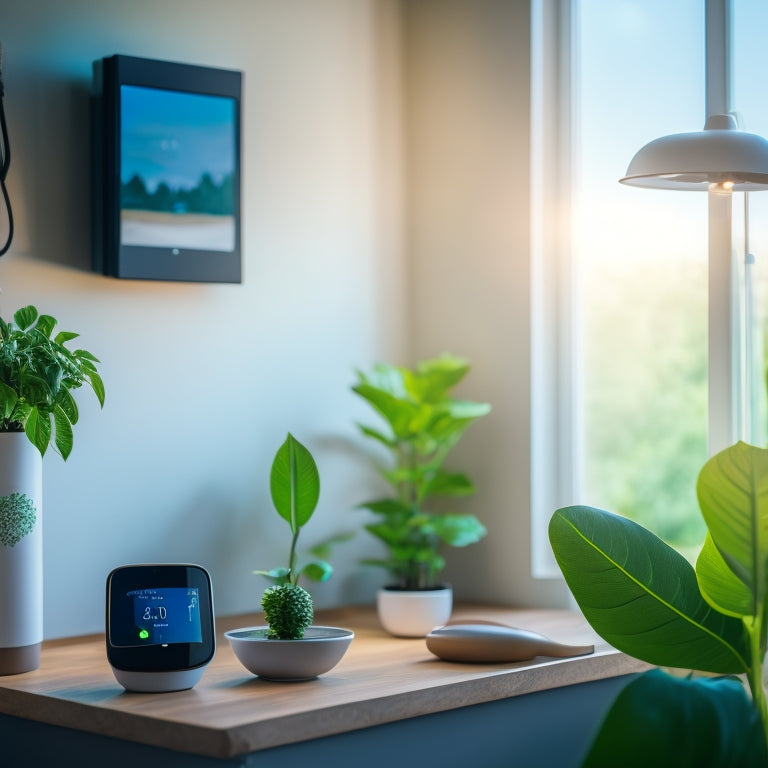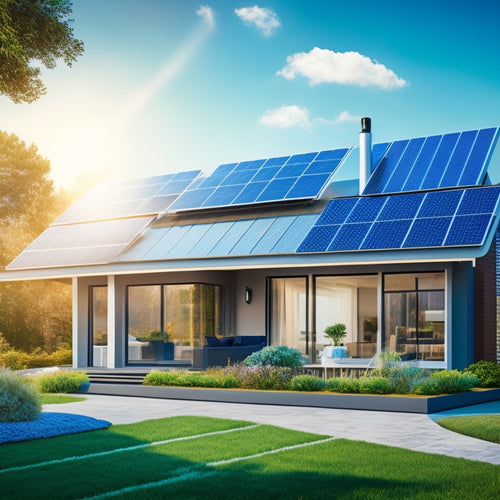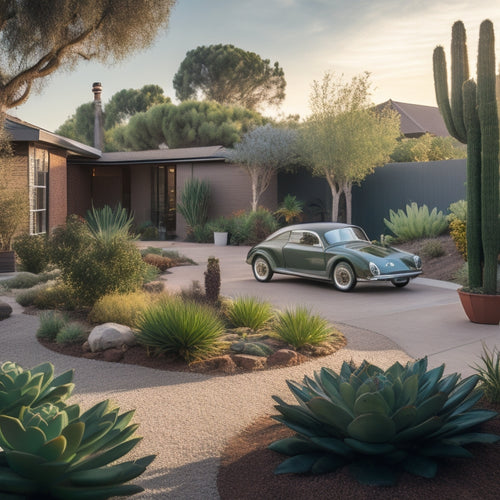
5 Best Home Automation Devices for Energy Efficiency
Share
You're looking to upgrade your home with the latest energy-efficient devices. You've got five top contenders to evaluate. Smart plugs monitor energy consumption, even when devices are turned off, and enable remote control. Automated lighting systems convert manual controls into automated processes, enhancing energy use. Energy-efficient thermostats reduce energy waste through smart programming, while smart home energy hubs centralize energy management for maximum efficiency. Last but not least, green power outlets minimize standby power consumption and provide eco-friendly features. Investigate these devices to uncover how they can help you reduce energy waste, cut costs, and create a more sustainable home.
Key Takeaways
- Smart plugs monitor energy consumption, enabling real-time tracking and remote control to turn off devices when not in use for optimal energy efficiency.
- Automated lighting control systems transform manual control into automated processes, reducing waste and promoting efficient energy use.
- Energy-efficient thermostat solutions reduce energy usage through smart programming, scheduling, and integration with solar power for renewable energy utilization.
- Smart home energy hubs centralize energy management, integrating devices to optimize energy efficiency, and enable real-time monitoring to identify and adjust energy waste.
- Green power outlets equipped with eco-friendly features monitor individual device energy usage, schedule consumption, and allow remote control for convenient management.
Smart Plugs for Energy Monitoring
How much energy do your devices really consume when they're turned off but still plugged in? You might be surprised to learn that many devices continue to draw power even when they're not in use. This is known as "standby power" or "vampire power."
Implementing time-of-use rate strategies for cost-effective charging Time-of-Use Rate Optimization can also help reduce energy consumption. Smart plugs can help you monitor and control this energy usage.
With smart plug features like real-time energy monitoring and scheduling, you can see exactly how much energy each device is using and turn them off remotely when they're not in use.
Automated Lighting Control Systems
By the time you've finished getting ready in the morning, you've likely flipped a dozen light switches, and that's just the beginning.
Manual lighting control can be tedious and wasteful, but automated lighting control systems can transform the manner in which you light your home. With wireless lighting, you can control individual lights or entire rooms with a single command. Dimmer switches allow you to adjust brightness levels to suit your mood or task.
Additionally, incorporating fast charging infrastructure in your home automation system can optimize energy efficiency and reduce your carbon footprint. Automated systems can also be programmed to turn lights off when not in use, reducing energy waste.
Imagine coming home to a brightly lit living room, or having your lights automatically dim when you start watching a movie. With automated lighting control, you can enjoy the perfect ambiance while saving energy and increasing your freedom.
Energy-Efficient Thermostat Solutions
You've optimized your lighting with automated control systems, now it's time to focus on regulating your home's temperature.
Energy-efficient thermostat solutions can greatly reduce your energy usage. To further minimize energy waste, consider integrating solar power into your heating and cooling systems, allowing you to utilize renewable energy and reduce your reliance on the grid.
By installing a smart thermostat, you can program your temperature preferences and schedule to guarantee your heating and cooling systems only run when needed. This thermostat programming feature allows you to create customized temperature settings for different times of the day, such as when you're away or sleeping.
With real-time energy usage tracking, you can identify areas for improvement and make adjustments to maximize your energy savings.
Smart Home Energy Hubs Uncovered
Efficiency converges with innovation in smart home energy hubs, which serve as the central nervous system of your home's energy management system.
You'll have complete control over your energy usage, as these hubs integrate various smart devices to optimize energy efficiency. By incorporating solar-powered EV charging systems solar energy solutions, you can reduce your reliance on the grid and carbon footprint.
With smart home integration, you can monitor and manage energy usage tracking in real-time, identifying areas of waste and making adjustments accordingly. This centralized system enables you to make informed decisions about your energy consumption, reducing your carbon footprint and saving you money on utility bills.
Green Power Outlets for Savings
Sustainability takes a significant leap forward with green power outlets, designed to change the manner in which you consume energy in your home. These innovative outlets are equipped with eco-friendly features that help reduce power consumption, giving you more control over your energy usage. With the ability to monitor and manage the energy consumption of individual devices, you can identify areas of inefficiency and make adjustments to optimize your energy usage.
| Feature | Description | Benefit |
|---|---|---|
| Energy Monitoring | Tracks energy usage in real-time | Identifies areas of inefficiency |
| Scheduling | Allows you to schedule device usage | Reduces standby power consumption |
| Remote Control | Enables remote device control | Conveniently turn devices on/off from anywhere |
Frequently Asked Questions
Can Home Automation Devices Integrate With Existing Smart Home Systems?
You'll be glad to know that most home automation devices can seamlessly integrate with your existing smart home systems, thanks to smart integrations that guarantee system compatibility, allowing you to expand your setup without a hitch.
Do Energy-Efficient Devices Require Professional Installation or Setup?
Like a skillful key unfastening a puzzle, you'll find that most energy-efficient devices are surprisingly DIY-friendly, but some may require professional installation to access their full potential, so don't be afraid to get hands-on or call in the pros.
How Secure Are Home Automation Devices From Hacking and Data Breaches?
You're right to worry about hacking and data breaches; look for devices with strong security protocols, like two-factor authentication and regular firmware updates, that implement end-to-end data encryption to safeguard your personal info and guarantee your smart home remains secure.
Are Home Automation Devices Compatible With Older Homes or Buildings?
You'll be pleased to know that retrofit solutions make it possible to integrate home automation devices into older homes or buildings, allowing you to enjoy smart upgrades without sacrificing functionality or aesthetics, and still achieving energy efficiency.
Can Energy-Efficient Devices Be Controlled Remotely Through Mobile Apps?
Flip open your ancient flip phone (yep, we went there!) - you can remotely monitor and control energy-efficient devices through mobile apps, granting you freedom to manage your energy usage and optimize your home's energy management from anywhere, anytime.
Related Posts
-

Why Choose Cool Roofs in Scorching Climates?
You opt for cool roofs in scorching climates because they enable you to reclaim control over your energy consumption ...
-

7 Best Cool Roof Rebates for Energy-Savvy Homeowners
You're an energy-savvy homeowner looking to install a cool roof, and you're wondering which rebates can help you save...
-

What Water-Saving Gardens Complement Electric Vehicle Ownership?
As you pair your electric vehicle with a water-saving garden, you're not only reducing your carbon footprint but also...


